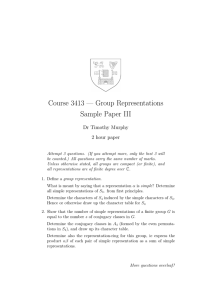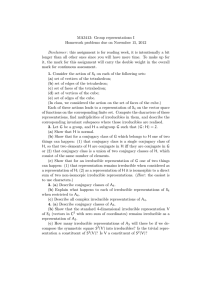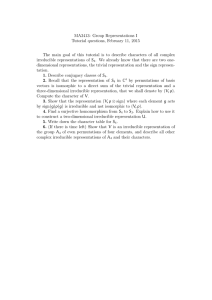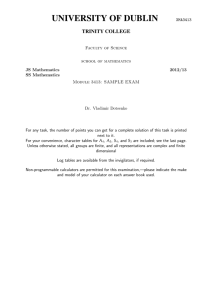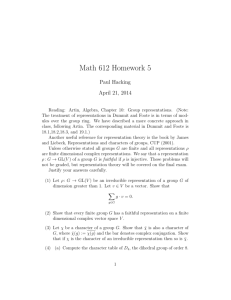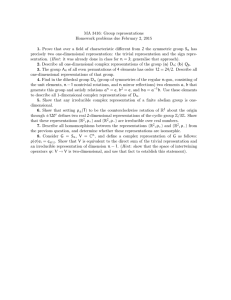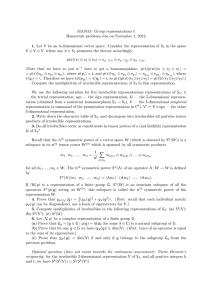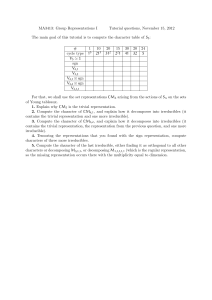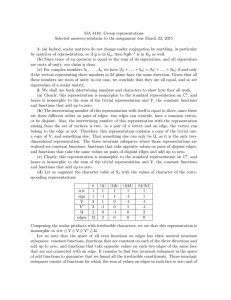3416: Group representations Dr. Vladimir Dotsenko (Vlad) Lecture 14
advertisement
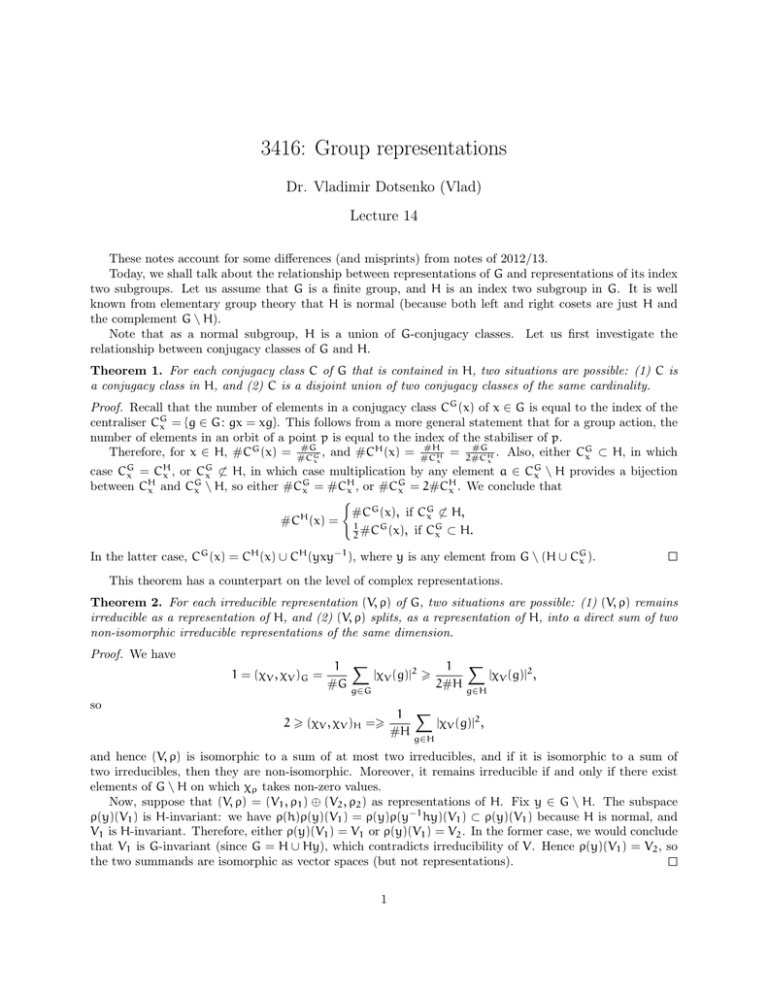
3416: Group representations
Dr. Vladimir Dotsenko (Vlad)
Lecture 14
These notes account for some differences (and misprints) from notes of 2012/13.
Today, we shall talk about the relationship between representations of G and representations of its index
two subgroups. Let us assume that G is a finite group, and H is an index two subgroup in G. It is well
known from elementary group theory that H is normal (because both left and right cosets are just H and
the complement G \ H).
Note that as a normal subgroup, H is a union of G-conjugacy classes. Let us first investigate the
relationship between conjugacy classes of G and H.
Theorem 1. For each conjugacy class C of G that is contained in H, two situations are possible: (1) C is
a conjugacy class in H, and (2) C is a disjoint union of two conjugacy classes of the same cardinality.
Proof. Recall that the number of elements in a conjugacy class CG (x) of x ∈ G is equal to the index of the
centraliser CG
x = {g ∈ G : gx = xg}. This follows from a more general statement that for a group action, the
number of elements in an orbit of a point p is equal to the index of the stabiliser of p.
#G
#H
#G
H
G
Therefore, for x ∈ H, #CG (x) = #C
G , and #C (x) = #CH = 2#CH . Also, either Cx ⊂ H, in which
x
x
x
G
G
H
case CG
x = Cx , or Cx 6⊂ H, in which case multiplication by any element a ∈ Cx \ H provides a bijection
H
G
H
G
G
H
between Cx and Cx \ H, so either #Cx = #Cx , or #Cx = 2#Cx . We conclude that
#CG (x), if CG
x 6⊂ H,
H
#C (x) = 1
G
G
2 #C (x), if Cx ⊂ H.
In the latter case, CG (x) = CH (x) ∪ CH (yxy−1 ), where y is any element from G \ (H ∪ CG
x ).
This theorem has a counterpart on the level of complex representations.
Theorem 2. For each irreducible representation (V, ρ) of G, two situations are possible: (1) (V, ρ) remains
irreducible as a representation of H, and (2) (V, ρ) splits, as a representation of H, into a direct sum of two
non-isomorphic irreducible representations of the same dimension.
Proof. We have
1 = (χV , χV )G =
1 X
1 X
|χV (g)|2 >
|χV (g)|2 ,
#G
2#H
g∈G
g∈H
so
2 > (χV , χV )H =>
1 X
|χV (g)|2 ,
#H
g∈H
and hence (V, ρ) is isomorphic to a sum of at most two irreducibles, and if it is isomorphic to a sum of
two irreducibles, then they are non-isomorphic. Moreover, it remains irreducible if and only if there exist
elements of G \ H on which χρ takes non-zero values.
Now, suppose that (V, ρ) = (V1 , ρ1 ) ⊕ (V2 , ρ2 ) as representations of H. Fix y ∈ G \ H. The subspace
ρ(y)(V1 ) is H-invariant: we have ρ(h)ρ(y)(V1 ) = ρ(y)ρ(y−1 hy)(V1 ) ⊂ ρ(y)(V1 ) because H is normal, and
V1 is H-invariant. Therefore, either ρ(y)(V1 ) = V1 or ρ(y)(V1 ) = V2 . In the former case, we would conclude
that V1 is G-invariant (since G = H ∪ Hy), which contradicts irreducibility of V. Hence ρ(y)(V1 ) = V2 , so
the two summands are isomorphic as vector spaces (but not representations).
1
Let us now apply this to the example A4 ⊂ S4 .
The conjugacy classes of even permutations in S4 are the unit element, the 3-cycles, and pairs of disjoint
transpositions. The centraliser of a 3-cycle is the cyclic subgroup generated by it, so it is contained in A4 ,
and the conjugacy class splits into two parts, {(123), (243), (134), (142)} and {(132), (124), (143), (234)}. The
centraliser of a product of two disjoint transpositions contains each of those transpositions, so the conjugacy
class does not split. Altogether, A4 has four conjugacy classes.
The irreducible representations of S4 are: the trivial representation and the sign representation (they
become the same one-dimensional representation of A4 ), the three-dimensional representation (V, ρ) and
(V, ρ ⊗ sgn) (they become the same representation of A4 , it is irreducible because the character χρ takes
non-zero values on some odd permutations), and the two-dimensional representation, for which the character
vanishes on all odd permutations, so this representation splits as a direct sum of two non-isomorphic onedimensional representations. Those are representations by cubic roots of unity that you constructed in
homework.
2

